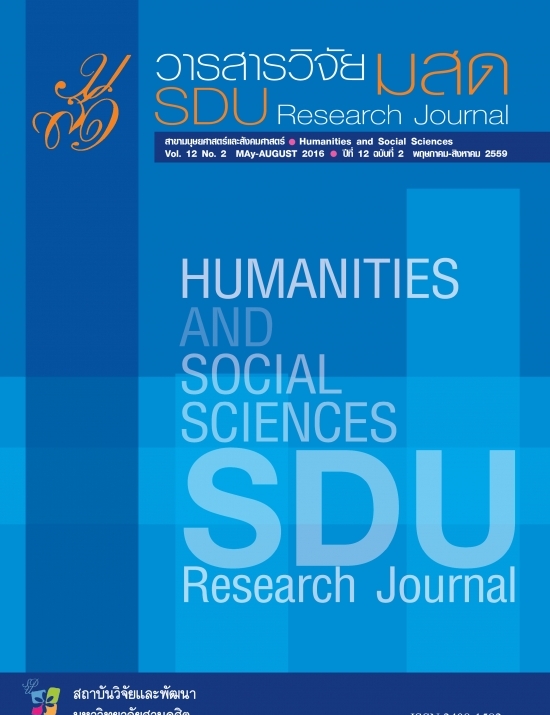การพัฒนาและตรวจสอบคุณภาพเครื่องมือวัดความยึดมั่นผูกพันการวิจัยของนักศึกษา ระดับดุษฎีบัณฑิตคณะครุศาสตร์/ศึกษาศาสตร์: การวิเคราะห์ด้วยภาวะน่าจะเป็นสูงสุดและเบส์
Keywords:
Research Engagement, Measurement Invariance, Bayesian Approach, Doctoral StudentsAbstract
มีงานวิจัยจำนวนมากที่ศึกษาความยึดมั่นผูกพันการวิจัย และส่วนใหญ่ใช้องค์ประกอบที่สอดคล้องกัน
แต่มีงานวิจัยจำนวนน้อยมากที่มุ่งพัฒนาโมเดลการวัดและเครื่องมือวัดความยึดมั่นผูกพันการวิจัย ด้วยเหตุนี้
งานวิจัยนี้จึงมีวัตถุประสงค์หลักในการวิจัย 1) เพื่อพัฒนาเครื่องมือและโมเดลการวัดความยึดมั่นผูกพัน
การวิจัย 2) เพื่อตรวจสอบความตรงเชิงโครงสร้างของโมเดลการวัดความยึดมั่นผูกพันการวิจัย 3) เพื่อตรวจสอบ
ความไม่แปรเปลี่ยนของโมเดลการวัดความยึดมั่นผูกพันการวิจัยของนักศึกษาระดับดุษฎีบัณฑิตคณะ
ครุศาสตร์/ศึกษาศาสตร์ในช่วงเวลาภาคต้นและภาคปลาย โดยเก็บข้อมูลจากภาคต้นปีการศึกษา 2558
จำนวน 46 คน และเก็บข้อมูลจากภาคปลายปีการศึกษา 2558 จำนวน 44 คน ในคณะครุศาสตร์
จุฬาลงกรณ์มหาวิทยาลัย แบบสอบถามเป็นมาตรประมาณค่า 5 ระดับ เครื่องมือวัดความยึดมั่นผูกพัน
การวิจัยประกอบด้วย 3 องค์ประกอบ ได้แก่ 1) การอ่านงานวิจัย 2) การใช้ผลการวิจัย และ 3) การทำงานวิจัย
การวิจัยครั้งนี้มีวัตถุประสงค์เพื่อวิเคราะห์องค์ประกอบเชิงยืนยันโดยพิจารณาความตรงเชิงโครงสร้าง
ขององค์ประกอบ และตรวจสอบความไม่แปรเปลี่ยนระหว่างเวลาภาคต้นและภาคปลาย โดยใช้การวิเคราะห์
ด้วยการประมาณค่าแบบภาวะน่าจะเป็นสูงสุดกับแบบเบส์ ผลการวิเคราะห์ พบว่า คุณภาพของเครื่องมือ
วัดความยึดมั่นผูกพันการวิจัยในการวัดทั้ง 2 ภาคการศึกษามีคุณภาพที่สอดคล้องกัน โดยมีความเที่ยงอยู่ใน
ระดับมากทุกองค์ประกอบ (Cronbach’s α > .8) ผลการวิเคราะห์ด้วยการวิเคราะห์แบบภาวะน่าจะเป็น
สูงสุดและแบบเบส์ให้ผลสอดคล้องกันที่ว่าโมเดลการวัดมีความสอดคล้องกลมกลืนกับข้อมูลเชิงประจักษ์
ทั้งข้อมูลชุดภาคต้นและภาคปลาย การประมาณค่าแบบภาวะน่าจะเป็นสูงสุด มีค่าสถิติ (1) = 0.038
p-value = .845 ในชุดข้อมูลภาคต้น และ (1) = 0.142 p-value = .706 ในชุดข้อมูลภาคปลาย
การประมาณค่าแบบเบส์มีค่า Posterior Predictive p-value = .421 ในชุดข้อมูลภาคต้น และ
มีค่า Posterior Predictive p-value = 0.341 ในชุดข้อมูลภาคปลายผลการวิเคราะห์ความไม่แปรเปลี่ยน
ระหว่างภาคการศึกษาของโมเดลการวัด พบว่า การประมาณค่าด้วยวิธีภาวะน่าจะเป็นสูงสุดให้ข้อสรุปว่า
โมเดลมีความไม่แปรเปลี่ยนเมื่อกำหนดให้ค่าพารามิเตอร์ สัมประสิทธิ์น้ำหนักองค์ประกอบ ค่าจุดตัดแกน
ค่าความคลาดเคลื่อนจากการวัด และค่าเฉลี่ยของตัวแปรแฝงเท่ากันทั้งโมเดลการวัดภาคการศึกษาต้นและ
ภาคปลาย การวิเคราะห์แบบภาวะน่าจะเป็นสูงสุดและแบบเบส์ให้ผลการวิเคราะห์สอดคล้องกัน เมื่อกำหนด
ให้ค่าพารามิเตอร์ของโมเดลการวัดทั้ง 2 ภาคการศึกษาเท่ากันจนถึงระดับสุดท้าย โมเดลยังคงสามารถ
อธิบายตัวแปรสังเกตได้อย่างมีนัยสำคัญทางสถิติ
References
391-429.
Congdon, P. (2014). Applied Bayesian Modelling. Chichester, U.K: Wiley.
Del Mar, C. & Askew, D. (2004). Building Family/General Practice Research Capacity.
The Annals of Family Medicine, 2, 35-40.
Fredricks, A. J. & Blumenfeld, P. C. (2004). School Engagement: Potential of the Concept,
State of the Evidence. Review of Educational Research, 74(1), 59-109.
Gelman, A., Hwang, J. & Vehtari, A. (2014). Understanding Predictive Information Criteria for
Bayesian Models. Statistics and Computing, 24(6), 997-1016.
George, D. & Mallery, P. (2010). SPSS for Windows Step by Step: A Simple Guide and
Reference. 17.0 Update. 10th ed. Boston: Allyn & Bacon.
Goldstein, H. & Browne, W. (2002). Multilevel Factor Analysis Modeling Using Markov Chain
Monte Carlo (MCMC) estimation. In G.A. Marcoulides & I. Moustaki (Eds.), Latent
Variable and Latent Structure Models. Mahwah, NJ: Erlbaum.
Hair, J., Black, W. C., Anderson, R. E. & Tatham, R. L. (2010). Multivariate Data Analysis.
7thed. Upper Saddle River, NJ: Pearson Prentice Hall
Kaplan, D. (2014). Bayesian Statistics for the Social Sciences. New York: Guilford
Publications.
Karlsson, U. & Törnquist, K. (2007). What do Swedish Occupational Therapists Feel about
Research? A Survey of Perceptions, Attitudes, Intentions, and Engagement.
Scandinavian Journal of Occupational Therapy, 14(4), 221-229.
Kong, Q. P., Wong, N. Y. & Lam, C. C. (2003). Student Engagement in Mathematics:
Development of Instrument and Validation of Construct. Mathematics Education
Research Journal, 15(1), 4-21.
Koyuncu, M., Burke, R. & Fiksenbaum, L. (2006). Work Engagement among Women
Managers and Professionals in a Turkish Bank: Potential Antecedents and
Consequences. Equal Opportunities International, 25(4), 299-310.
Loughran, J. (2014). Professionally Developing as a Teacher Educator. Journal of Teacher
Education, 65(4), 271-283.
Merkle, E. C. & Rosseel, Y. (2015). Blavaan: Bayesian Structural Equation Models via
Parameter Expansion. Retrieved May 12, 2016, from http://arxiv.org/abs/
1511.05604.
Munthe, E. & Rogne, M. (2015). Research based Teacher Education. Teaching and Teacher
Education, 46, 17-24.
Muthen, B. & Asparouhov, T. (2012). Structural Equation Modeling: a more Flexible
Representation of Substantive Theory. Psychological Methods, 17(3), 313-335.
Ozechowski, T. J. (2014). Empirical Bayes MCMC Estimation for Modeling Treatment
Processes, Mechanisms of Change, and Clinical Outcomes in Small Samples.
Journal of Consulting and Clinical Psychology, 82(5), 854-867.
Prasertsin, U. (2012). Research and Development of Teachers’ Research Engagement using
Empowerment Technique. (Doctoral’s dissertation). Chulalongkorn University,
Bangkok. (in Thai)
Prasertsin, U. (2012). Research and Development of Teachers’ Research Engagement using
Empowerment Technique. (Doctoral’s dissertation). Chulalongkorn University,
Bangkok. (in Thai)
R Core Team. (2015). R: A Language and Environment for Statistical Computing. R
Foun- dation for Statistical Computing. Retrieved May 12, 2016, from http://
www.R-project.org/.
Sun, J. C. Y. & Rueda, R. (2012). Situational Interest, Computer Self-efficacy and Selfregulation:
Their Impact on Student Engagement in Distance Education. British
Journal of Educational Technology, 43(2), 191-204.
Revelle, W. (2016). Psych: Procedures for Personality and Psychological Research.
Retrieved May 12, 2016, from http://http://CRAN.R-project.org/package=psych
Version = 1.6.4.
Rosseel, Y. (2012). Lavaan: An R Package for Structural Equation Modeling. Journal of
Statistical Software, 48(2), 1-36.
SemTools Contributors. (2016). SemTools: Useful Tools for Structural Equation Modeling.
R Package Version 0.4-11. Retrieved May 12, 2016, from http://cran.r-project.org/
package=semTools.
Schaufeli, W. B. & Bakker, A. B. (2004). Job Demands, Job Resources, and their Relationship
with Burnout and Engagement: A Multi-sample Study. Journal of Organizational
Behavior, 25(3), 293-315.
Schoot, R., Kaplan, D., Denissen, J., Asendorpf, J. B., Neyer, F. J. & Aken, M. A. (2014).
A Gentle Introduction to Bayesian Analysis: Applications to Developmental
Research. Child Development, 85(3), 842-860.
Snelgrove, S. & James, M. (2010). Graduate Nurses’ and Midwives’ Perceptions of Research.
Journal of Research in Nursing, 16(11), 7-20.
Trowler, V. (2010). Student Engagement Literature Review. Retrieved May 12, 2016, from http://
www.heacademy.ac.uk/sites/default/files/studentengagementliteraturereview_1.pdf.
Van de Schoot, R., Broere, J. J., Perryck, K. H., Zondervan-Zwijnenburg, M. & Van Loey, N. E.
(2015). Analyzing Small Data Sets using Bayesian Estimation: the Case of
Posttraumatic Stresssymptoms following Mechanical Ventilation in Burn Survivors.
European Journal of Psychotraumatology, 6, 25216.
Van de Schoot, R., Lugtig, P. & Hox, J. (2012). A Checklist for Testing Measurement
Invariance. European Journal of Developmental Psychology, 9(4), 486-492.
Wonglorsaichon, B. (2012). Strategies for Enhancing School Engagement of Students from
the Results of SEM Analysis: Development and Implementation. (Doctoral’s
dissertation). Chulalongkorn University, Bangkok. (in Thai)
West, S. G., Taylor, A. B. & Wu, W. (2012). Model Fit and Model Selection in Structural
Equation Modeling. In R. H. Hoyle (Ed.), Handbook of Structural Equation
Modeling. New York: Guilford Press.








